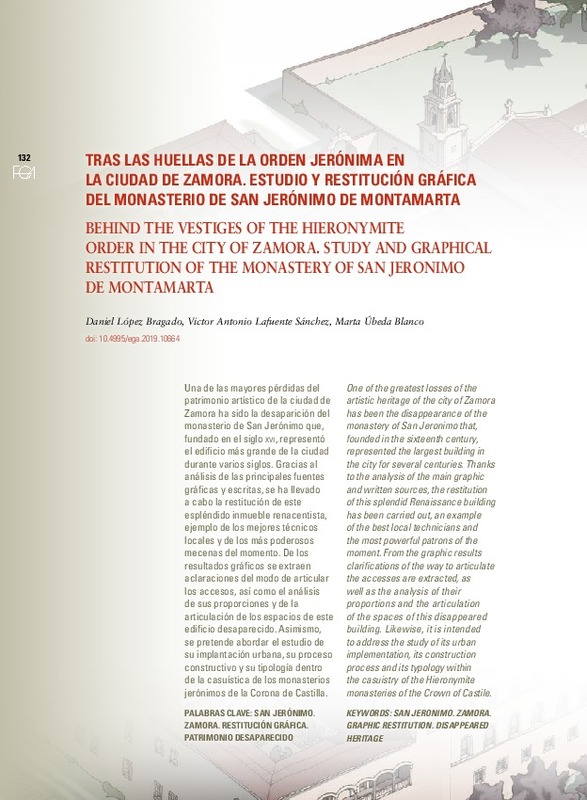JavaScript is disabled for your browser. Some features of this site may not work without it.
Buscar en RiuNet
Listar
Mi cuenta
Estadísticas
Ayuda RiuNet
Admin. UPV
Behind the vestiges of the hieronymite order in the city of Zamora. Study and graphical restitution of the Monastery of San Jeronimo de Montamarta
Mostrar el registro sencillo del ítem
Ficheros en el ítem
| dc.contributor.author | López Bragado, Daniel
|
es_ES |
| dc.contributor.author | Lafuente Sánchez, Víctor Antonio
|
es_ES |
| dc.contributor.author | Úbeda Blanco, Marta
|
es_ES |
| dc.coverage.spatial | east=-5.7467879; north=41.5034712; name=Zamora, Espanya | es_ES |
| dc.date.accessioned | 2020-02-20T10:15:41Z | |
| dc.date.available | 2020-02-20T10:15:41Z | |
| dc.date.issued | 2019-11-18 | |
| dc.identifier.issn | 1133-6137 | |
| dc.identifier.uri | http://hdl.handle.net/10251/137367 | |
| dc.description.abstract | [ES] Una de las mayores pérdidas del patrimonio artístico de la ciudad de Zamora ha sido la desaparición del monasterio de San Jerónimo que, fundado en el siglo XVI, representó el edificio más grande de la ciudad durante varios siglos. Gracias al análisis de las principales fuentes gráficas y escritas, se ha llevado a cabo la restitución de este espléndido inmueble renacentista, ejemplo de los mejores técnicos locales y de los más poderosos mecenas del momento. De los resultados gráficos se extraen aclaraciones del modo de articular los accesos, así como el análisis de sus proporciones y de la articulación de los espacios de este edificio desaparecido. Asimismo, se pretende abordar el estudio de su implantación urbana, su proceso constructivo y su tipología dentro de la casuística de los monasterios jerónimos de la Corona de Castilla. | es_ES |
| dc.description.abstract | [EN] One of the greatest losses of the artistic heritage of the city of Zamora has been the disappearance of the monastery of San Jeronimo that, founded in the sixteenth century, represented the largest building in the city for several centuries. Thanks to the analysis of the main graphic and written sources, the restitution of this splendid Renaissance building has been carried out, an example of the best local technicians and the most powerful patrons of the moment. From the graphic results clarifications of the way to articulate the accesses are extracted, as well as the analysis of their proportions and the articulation of the spaces of this disappeared building. Likewise, it is intended to address the study of its urban implementation, its construction process and its typology within the casuistry of the Hieronymite monasteries of the Crown of Castile. | es_ES |
| dc.language | Español | es_ES |
| dc.language | Inglés | es_ES |
| dc.publisher | Universitat Politècnica de València | es_ES |
| dc.relation.ispartof | EGA Expresión Gráfica Arquitectónica | es_ES |
| dc.rights | Reconocimiento - No comercial - Sin obra derivada (by-nc-nd) | es_ES |
| dc.subject | San Jeronimo | es_ES |
| dc.subject | Zamora | es_ES |
| dc.subject | Graphic restitution | es_ES |
| dc.subject | Disappeared heritage | es_ES |
| dc.subject | San Jerónimo | es_ES |
| dc.subject | Restitución gráfica | es_ES |
| dc.subject | Patrimonio desaparecido | es_ES |
| dc.title | Behind the vestiges of the hieronymite order in the city of Zamora. Study and graphical restitution of the Monastery of San Jeronimo de Montamarta | es_ES |
| dc.title.alternative | Tras las huellas de la orden jerónima en la ciudad de Zamora. Estudio y restitución gráfica del Monasterio de San Jerónimo de Montamarta | es_ES |
| dc.type | Artículo | es_ES |
| dc.identifier.doi | 10.4995/ega.2019.10664 | |
| dc.rights.accessRights | Abierto | es_ES |
| dc.description.bibliographicCitation | López Bragado, D.; Lafuente Sánchez, VA.; Úbeda Blanco, M. (2019). Behind the vestiges of the hieronymite order in the city of Zamora. Study and graphical restitution of the Monastery of San Jeronimo de Montamarta. EGA Expresión Gráfica Arquitectónica. 24(37):132-143. https://doi.org/10.4995/ega.2019.10664 | es_ES |
| dc.description.accrualMethod | OJS | es_ES |
| dc.relation.publisherversion | https://doi.org/10.4995/ega.2019.10664 | es_ES |
| dc.description.upvformatpinicio | 132 | es_ES |
| dc.description.upvformatpfin | 143 | es_ES |
| dc.type.version | info:eu-repo/semantics/publishedVersion | es_ES |
| dc.description.volume | 24 | es_ES |
| dc.description.issue | 37 | es_ES |
| dc.identifier.eissn | 2254-6103 | |
| dc.relation.pasarela | OJS\10664 | es_ES |
| dc.description.references | CASTRO SANTAMARÍA, A., 1993. "El monasterio de San Jerónimo de Zamora en el siglo XVI". Anuario 1993 del Instituto de Estudios Zamoranos Florián de Ocampo, pp. 247-270. | es_ES |
| dc.description.references | CHÍAS NAVARRO, P., SENDER, M., 2015. "Nuevos enfoques en el estudio de los Monasterios Jerónimos. Santa María de la Murta y San Lorenzo de El Escorial: Organización funcional y tipologías". Revista EGA, nº 26, pp. 84-91. | es_ES |
| dc.description.references | ISIDRO GARCÍA, C.A., 2015. El arte de los monasterios jerónimos de la provincia de Zamora. (Tesis doctoral inédita, Universidad de Salamanca). | es_ES |
| dc.description.references | RODRÍGUEZ MÉNDEZ, F.J., GARCÍA GAGO, J.M. 2014. "Wyngaerde en Zamora". Revista EGE, nº 8, pp. 67-75. | es_ES |
| dc.description.references | RUIZ HERNANDO, J.A., 1997. Los monasterios jerónimos españoles. Caja Segovia. | es_ES |
| dc.description.references | VASALLO TORANZO, L., 2004. "Juan de Álava y Pedro de Ibarra al servicio de los condes de Alba de Aliste". Boletín del Seminario de Estudios de Arte y Arqueología, nº 69/70, pp. 279-302. | es_ES |








